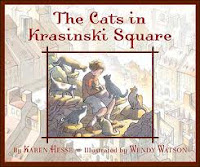Greetings and Salutations!
Welcome to my readers' advisory blog 'Hope and Remembrance' - the blog that promotes children's literature and online resources that commemorates that Holocaust.
Why the Holocaust? In recognising the United Nation's International Day of Commemoration in Memory of Victims of the Holocaust, I wanted to find resources suitable for children, that could educate and inform, without being too detailed and upsetting.
In doing this, my blog is designed is to be super user friendly for children! Instead of a proper annotated bibliography, my reviews are ranked according recommended reading ages - the youngest start at the top and the oldest at the bottom.
If you see a word that looks like this click on the link! It could take you a website or it could give you the meaning of a really hard word.
Why is it important to remember the Holocaust? In total, 11 million lives were lost. 6 million of those were Jewish - others died because they were disabled, mentally ill or disagreed with what Hitler and the Nazis were doing - and these are only a couple of examples.
It is important to remember why people lost their lives and we can only hope and pray that this history does not repeat itself.
I hope you find this blog useful.
Best wishes,
Phillippa
I hope you find this blog useful.
Best wishes,
Phillippa











